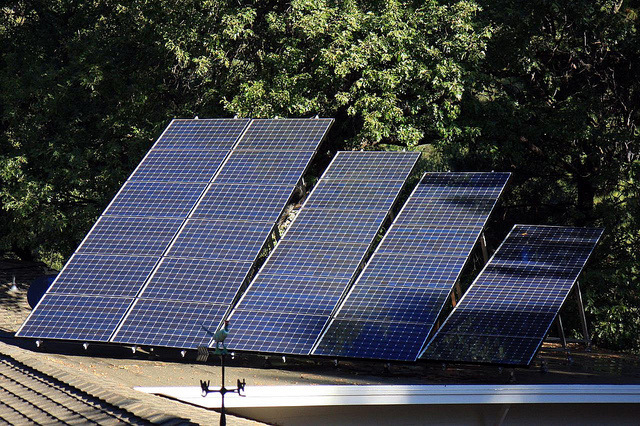This post addresses a problem specific to solar PV modules that use string_inverters, which are the most common kinds of inverters. For an introduction to solar PV technology, see my previous post.

Every manufacturer will tell you to avoid obstructions to your array—trees,antennae, bird droppings, what have you. But they really mean it, and the reason might not be so obvious.
The long and short of it is that partial shading of one module can compromise the output of the entire array. Here’s how:
Remember that it’s the inverter’s responsibility to convert the DC power generated by the solar panels into AC power for use in the house. Well, one reason we use AC is because it’s especially easy to get along with. AC power is expressed as a ratio of voltage to current (volts to amps), and it can be converted between different ratios rather easily. This way it can conform to the requirements of everything from your washing machine to your cell phone charger. Each appliance’s voltage/current preference is determined by how it uses electricity to perform its tasks.
When a string inverter changes the DC power from a solar array into AC power for the house, it has to choose a voltage/current ratio, too. The optimal ratio is whatever ratio provides the most power, so it’s referred to as the maximum power point. Under varying conditions of temperature and sunlight, the maximum power point is constantly changing. Many solar inverters available today come with maximum power point tracking, a.k.a. MPPT, which means they’re constantly probing the system to find the right ratio and making adjustments in real time.
Now, at any given time, most string inverters can only accept one MPP—one voltage/current ratio—for all the modules under their charge. Partial shading means there’s at least one module that can’t generate at the power of the other ones. In this case, most systems have two options. The first option is to compromise: the inverter’s MPPT will choose a lower power point at which all the panels can generate together.* In this sense, the entire array is only as strong as its weakest link. The inverter’s other option is to refuse the power from the shaded module. This isn’t an ideal situation; it means the shaded module has to dump what current it is generating through a bypass diode so that it’s discharged peacefully. But think of the poor bypass diode… it would be like entering and exiting a building through the fire escape every day – your apartment’s not designed for that! Clearly though, either situation — the bypass or the lower power point — is undesirable.
There’s a technology called the microinverter that seeks, among other things, to avoid this problem altogether by giving each panel has its own small inverter. So if one module has partial shading, then it generates at whatever power point it can, and the others carry on in peace. Some microinverters are even built-in on the level of the solar cells. The technology has been around for a while, but only recently has it become economical.
String inverters are tried and true, but to keep things running smoothly, keep your panels sunny!
* For this reason as well, you’ll want to get more than one inverter if your array features modules with different orientations.
Partial shading is worse than it sounds.
This entry was posted in renewable-energy, renooble, solar-PV and tagged inverter, partial shading, photovoltaics, PV, shading, solar, string inverter. Bookmark the permalink.